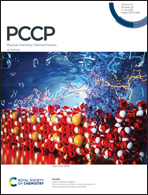First principles investigations on the controversy of structural phase transitions in thorium dialuminide under pressure
Abstract
We study the high pressure structural aspects of thorium dialuminide, ThAl2, by performing evolutionary crystal structure searches and first principles calculations. We predict a phase transition from the ambient AlB2-type hexagonal structure to a P63/mmc hexagonal structure above 2.4 GPa. We also note that the new structure remains stable up to 50 GPa. This differs from the finding of an earlier study in which three phase transitions were reported close to 5.5, 12 and 25 GPa. An analysis of the electronic structures, Bader charge and electron localization function (ELF) indicates a complex chemical bonding comprising partial metallic, ionic (Th–Al) and covalent (Al–Al) characters in the ambient phase. Comparison of crystal parameters and ELFs for ambient and high pressure phases indicates that a change of Al–Al bonding under pressure is responsible for the structural phase transition. Furthermore, we computed the high P–T phase diagram by including the temperature effects via free energies for the most relevant structures, namely, AlB2-type, MgCu2-type and new hexagonal. We found that a MgCu2-type structure becomes stable only under high P–T conditions. We also provide a plausible explanation for the observed isostructural transition in the ambient AlB2-type structure at 5.5 GPa.



 Please wait while we load your content...
Please wait while we load your content...